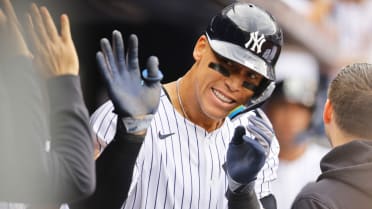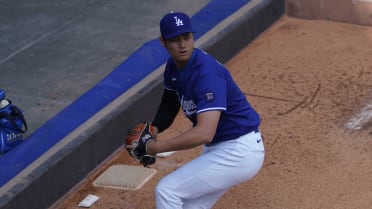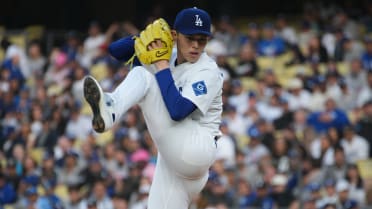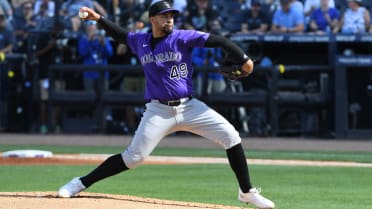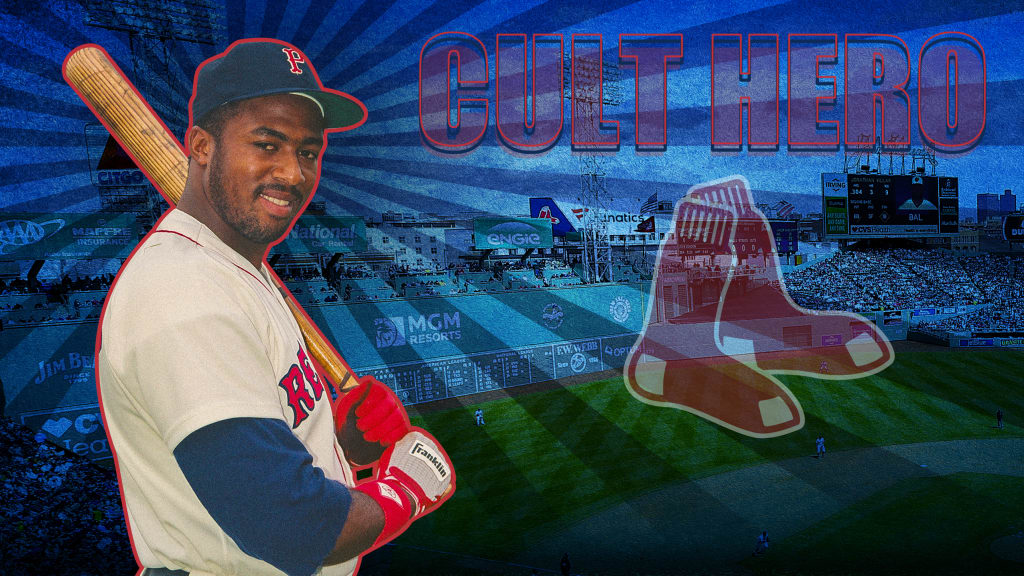
BOSTON -- A big lefty slugger with major power and a big smile. Someone Red Sox fans took to immediately.
To those in New England, this all sounds eerily familiar.
But we aren’t talking about David Ortiz, who went on to be one of the most iconic players in team history.
The man who fit that description for Boston in 1987 was Sam Horn, a first-round Draft selection from five years prior who hit tape-measure home runs to swiftly reach cult-hero status.
The difference is that, unlike Ortiz or Mo Vaughn, Horn never reached sustained greatness in his career after a highly promising start. Yet he resonated enough with die-hard fans of a certain age that a fan website -- SonsofSamHorn.net -- was named in his honor roughly two decades ago, and it’s still going strong.
Horn, who was 6-foot-5 and weighed 250 pounds, still wonders what could have been if an organization had gone all-in on him as an everyday designated hitter like the Red Sox eventually did with Ortiz.
“I love Big Papi,” Horn said. “And the reason why I love Big Papi was because I saw myself in him. I used to hug him before a game and say, ‘Good luck,’ and I meant it from the bottom of my heart. Because I felt like every time I hugged him, the true feeling of what I felt that I could have done came out. I was hoping it was going inside of David, and it was hopefully giving him even more ability or more strength to go out and perform as a pure DH.”
What a debut
By the midway point of 1987, it was clear that the Red Sox weren’t going to repeat their pennant-winning campaign of the year prior. So general manager Lou Gorman decided to turn to a youth movement in July, which in turn brought excitement to the fans.
Ellis Burks, Mike Greenwell and Todd Benzinger were the first prospects who got a chance to contribute that summer. And in late July, after Bill Buckner was released, the Sox made another call to Pawtucket, telling Horn it was time to come on up to Fenway. Horn was in the midst of a monster year at Triple-A.
“Well, it was a long time coming. I was definitely wondering when my time would come, when my number would be called for the simple fact that I had already hit 30 home runs, 84 RBIs and I was hitting .321 at the time,” said Horn. “I couldn’t wait, because once I got there, I knew I was ready and I knew it was my time.”
July 25 was the day that manager John McNamara put Horn in the lineup for a Saturday afternoon game at Fenway Park against the Mariners.
Eventual Hall of Famers Wade Boggs and Jim Rice batted third and fourth, respectively, for the Sox that day. Horn was in the five-hole, right in front of another star player in Dwight Evans.
In the bottom of the fifth inning, the game was tied when Horn got ready to hit against Mariners lefty Stan Clarke.
“It was my third at-bat, and I remember it like it was yesterday,” Horn said. “My first time up, I actually struck out and then my second time up, I hit into a double play, so I’m like, ‘Damn, two at-bats, three outs.’ My third at-bat, Stan Clarke was on the mound. He was a lefty and I remember I didn’t want to look around.
“John McNamara was calling me, and I figured it was to say, ‘I have a pinch-hitter for you.’ So I was ignoring him. He kept calling me. I heard him, but I just never looked over,” Horn said. “I guess he told the bat boy to get my attention. So the bat boy tapped me, and I was like, 'Here it is.' But I looked at John McNamara, and he gives me the thumbs up. And he says, like, ‘Good luck.’ He stayed with me. That made me feel good.”
So good, in fact, that Horn hammered a two-run homer into the netting above the Green Monster to give the Sox a 7-5 lead in an eventual 11-5 win. Fenway fans roared with approval, including current team president/CEO Sam Kennedy, who was in high school at the time and was sitting in the grandstands in Section 25, right down the third-base line.
“I can barely remember where I had dinner last night, but I can tell you where I was sitting in 1987 when Sam hit that bomb in his Major League debut,” Kennedy said. “I guess all his home runs were memorable, given the moon shots he hit.”
Fenway Fridge has launch party
If hitting a homer in his debut wasn’t a big enough thrill, Horn went deep again the next day to support a 14-strikeout performance by Roger Clemens. He then bashed three homers on the subsequent road trip.
Horn had 10 homers in his first 31 games, placing him third in team history behind George Scott (1966) and Michael Chavis (2019) as the fastest to reach double digits in his career.
The lefty was hitting at such an eye-popping clip that he quickly received a nickname of the “Fenway Fridge.” At the time, William “The Refrigerator” Perry was all the rage for the Chicago Bears.
“I loved it,” Horn said. “For them to equate me to one of the biggest stars in football at the time, because the Bears had just won the Super Bowl -- William ‘The Refrigerator’ Perry was the man. He was everything. He was making tackles and scoring touchdowns, and I just remembered one day, somebody said, ‘Hey, you’re big, you’re nice, we’re going to call you the Fenway Fridge.’ It didn’t bother me because I wasn’t fat or out of shape or anything. Now that I’m 56 years old, I do have a little baby fridge still.”
By the time the 1987 season had ended, Horn had ripped 14 homers in 158 at-bats. He had a .945 OPS.
And the fans loved him.
“The fans felt the love that I gave them,” Horn said. “I recall talking to the peanut guy out in front and he said, ‘Sam you’re the only player that I’ve known to come out before the game and sign autographs and sign autographs after the game.’ If I was on way to the ballpark, I would stop outside and sign autographs.
“I thought it was more valuable being up close and personal with the fans when I was able to go to the ballpark, and if I had a tough day, the fans knew it, they wouldn’t boo. They would give me a vote of confidence because they knew I was definitely trying to give it my all for the fans, because I was definitely a Fenway favorite for the simple fact that I catered to the fans.”
Horn had a couple of huge fans in Kennedy and eventual Red Sox general manager Theo Epstein, who were high school classmates and baseball teammates in Brookline, Mass.
“As high school players we loved his stance, his power and the enthusiasm he brought to Fenway,” Kennedy said. “When Theo and I came back home to work for the Sox, and we would see Sammy in the NESN studio down the hall, we would say to each other, ‘Do we actually work on the same floor as Sam Horn?’”
The letdown
At Spring Training 1988, Horn seemed ready to duplicate his ’87 magic. Take that day in March at Tinker Field in Orlando, Fla., against the Twins, for example, when Horn hit a ball that soared out of the ballpark before landing just beneath the press box of the Citrus Bowl.
Tinker Field historians said it was one of the longest home runs ever hit at the park. They estimated the ball would have traveled at least 450 feet.
Horn broke camp with the Red Sox, making the Opening Day roster for the first time in his career and earning a spot in the lineup, where he drove in two runs in a Fenway loss to the Tigers. He got two hits in the second game of the season, helping Boston to a 6-5 win. From there, however, Horn’s playing time was sporadic. The Red Sox had a logjam of players for whom McNamara had to find playing time. And when Greenwell -- who would finish second in the American League Most Valuable Player Award race that season -- emerged as the starting left fielder, Rice became the DH.
That left Horn in a role he was ill-suited for: part-time player.
“If you look at it, Jim Rice was playing DH, and I was basically playing in a sandbox,” Horn said. “I just sat around waiting on an opportunity.”
By June 4, Horn had just nine hits (including two homers) compared to 20 strikeouts in 61 at-bats and a .520 OPS. The Red Sox sent him back to Pawtucket, and he wouldn’t spend another day on Boston’s roster that season.
At Spring Training 1989, Horn again tried to earn a spot, even as his defense at first base lagged well behind his offense.
“Defensively, he was so bad, it was comical,” said Boston Globe columnist Dan Shaughnessy, who was on the Red Sox beat in those days. “We were in Lakeland, they put him over there and the Tigers hit like three balls to him in the first inning. It’s like in basketball, they sense a weakness and go after him. The Tigers were going at him.
“My contention was anybody could play first base. I remember Ed Nottle was the manager in Pawtucket and Ed said, ‘Yeah, that’s not true. I’ve hit him my million grounders. You go hit him yours.’”
Horn made the team again in 1989, but manager Joe Morgan hardly gave him a shot. He didn’t start once in the first 18 games. No wonder that when Horn finally got into the lineup on April 27, he was rusty, going 0-for-6 with three strikeouts. He then went back to the bench for 14 straight games before Morgan gave him another shot. By June 7, with a .114 batting average and no homers in 44 at-bats, Horn headed back to Pawtucket. He returned as a September callup but hardly played.
Horn was released five days before Christmas. His playing career with the Red Sox was over.
Redemption and retirement
Exactly two months after his departure from the Red Sox, Horn was signed by the Orioles. On Opening Day 1990 in Kansas City, Horn went on a tear for Baltimore, going 4-for-5 with two homers and six RBIs. Serving as a platoon player that year, he belted 14 homers and had a sturdy .804 OPS in 246 at-bats.
The next season, Horn played in a career-high 121 games and ripped 23 big flies in 317 at-bats. Things were looking up for the left-handed masher, who was loving the chance to get playing time and absorb the leadership of the legendary Cal Ripken Jr.
Heading into 1992, the Orioles were moving into Camden Yards, and the thinking was that Horn would wear out Eutaw Street while taking aim at the B&O Warehouse. But the bottom fell out again, thanks to the deprivation of opportunity. Glenn Davis had come over as a free agent and was originally supposed to be the first baseman. But after injuries cropped up early, Davis moved to DH, leaving Horn without a spot. Horn totaled 162 at-bats and five homers in his final season with the O's.
“I looked forward to that ’92 season because everyone was banking on, ‘Sam Horn is going to hit the warehouse,’” Horn said. “Trust me, it was hard to hit the warehouse from where I was sitting.”
After Baltimore, Horn was hardly heard from again. He got hot as a September callup with the 1993 Indians -- batting .455 with four homers -- but that team was loaded with offensive talent. He finished his career with the Rangers in ‘95, getting just nine at-bats.
The way Horn looks at it, two things prevented him from earning the at-bats he needed to establish himself. The first was his glove -- which was shoddy, to put it kindly. The second was that he never got his desired opportunity -- the chance to be a full-time DH.
“Whether I was a liability or not, my glove gave me a rash,” Horn said. “That was my downfall. My downfall was that mentally, it got in my head that I wasn’t a good first baseman. I came to work just like Wade Boggs did when they said he wasn’t a good third baseman. And he worked very hard. He took a thousand ground balls every day, and he was able to get better. But he also got better with the opportunity to be there and play. I never got a chance to play, let alone just be the DH.”
Sons of Sam Horn
In the mid-to-late 1990s, after Horn was out of MLB, a group of a dozen sophisticated Red Sox fans communicated daily in a fan forum page on a website that was named after former Major Leaguer Dickie Thon.
When the Dickie Thon site stopped running, the forum of Red Sox discussions got taken down as well.
A man named Eric Christensen took leadership for the group of Sox fans by finding somewhere else they could post their chats. He found an ezboard forum, which was meant for people with little to no experience running a website. But Christensen needed a name for the site.
“I was coming up with all this really quick,” Christensen recalled. “You had to give it a name. I didn’t want to call it Red Sox forum. We just wanted to keep that signal-to-noise ratio where we were accustomed to having it in our own little private thing on the internet.
“The first thing that popped into my head was like the Sons of Sam Horn or something. I guess it was kind of a play on the Son of Sam, and obviously that had a bad connotation, but at the same time, only a hardcore Red Sox fan would know who Sam Horn was. So that played into our idea of limiting the site to only the most die-hard fans.”
Christensen indeed founded the site named Sons of Sam Horn, which rose to prominence in November 2003 when Curt Schilling actually interacted with fans on the website while the Red Sox were in the process of acquiring him from the Arizona Diamondbacks. Owner John Henry and Epstein added visibility to the site by participating in chats.
Horn partnered with Christensen, and the former slugger is now the president of the website, though he is the first to admit he lets other people run it. Christensen, who has made a career working in paper mills, is no longer involved.
“It takes a lot of work to run a website and update a website and all of that, so I told the people, as long as you don’t do anything negative, it can only be a positive for me because it’s positive social media,” Horn said. “It wasn’t big at the time, but it got big. I remember getting 300,000-plus unique visitors at one point.”
Horn realizes that the site has added to his legacy.
“They are the ones who said, ‘Sam, because you’re such a nice person, because you were a person that people wanted to do well, that’s why they call it Sons of Sam Horn.’ They called me a cult hero,” Horn said. “I didn’t call myself that.”
And now?
Horn is still a frequent visitor to Fenway Park, serving as a corporate ambassador for the club. His connection with Kennedy helped keep him in the Red Sox family.
“The Red Sox believe in me enough,” Horn said, “and that’s why Sam Kennedy is on that short list of people in baseball that I love.”
Kennedy enjoys seeing Horn around the ballpark.
“Sam is an amazing representative for the Red Sox -- he is fun, engaging, humble and respects our fans who love him,” Kennedy said. “I get to see him on most nights at the ballpark and he brings a huge smile to my face. We are lucky to have him as a part of the Red Sox family.”
At one point, Horn was a NESN studio analyst. He is still interested in media ventures. In fact, Horn is trying to resurrect a show he had on NBC Sports Boston a couple of years ago called, “What is your pregame?”
Horn is at peace with the way his baseball career turned out.
“The people who know me, they say, ‘That guy right there, he struck out a lot, but he was the kind of guy that you wanted to make sure and watch, because if he did hit it, he either hit it really hard or really far,'” Horn said. “I liked that.”
Supervising Club Reporter Ian Browne has covered the Red Sox for MLB.com since 2002.

